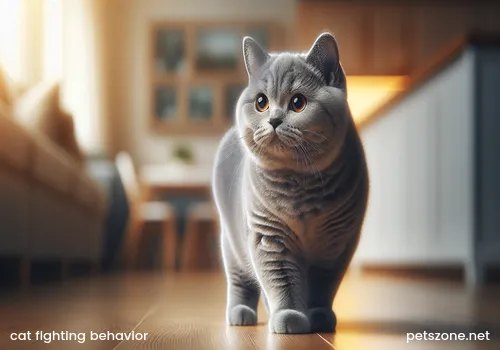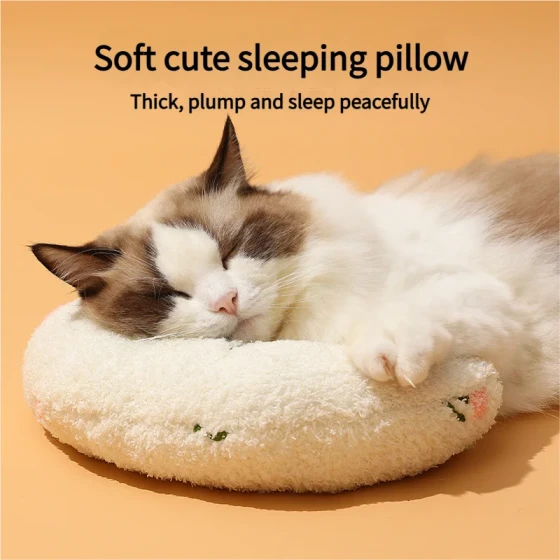Cat Pressing Another Cat and Biting_Analysis of the Reasons Behind Cat Fighting Behavior
When seeing one cat pressing down on another cat and biting, this may cause many cat owners to worry. This behavior might be play or a more serious aggressive act. Understanding the reasons behind it is crucial for maintaining cats’ health and household harmony.
When a cat presses down and bites another cat, it can be normal or abnormal behavior for various reasons. Common possibilities include:

- Play Behavior: This is one of the most common reasons, especially for young cats. By simulating hunting and fighting, cats learn social skills and control their bite strength.
- Establishing Rank or Dominance: In multi-cat households, cats may use this behavior to establish or maintain social status among each other.
- Mating Behavior: Unneutered male cats bite the female's neck to hold her in place when attempting to mate.
- Aggressive Behavior: If the behavior is accompanied by hissing, growling, puffed fur, or causes injury, it may be territorial aggression, fear aggression, or other forms of attack.
- Redirected Aggression: When cats cannot directly attack the source of their frustration (e.g., another cat outside the window), they might redirect aggression onto another cat at home.
- Physical Discomfort or Pain: Physical discomfort or pain can also lead to aggressive behavior in cats.
Distinguishing whether cats are playing or truly fighting is very important and can be judged by observing their body language, sounds, and interaction patterns.
How to Tell if Cats are Playing or Fighting?
To determine if cats are roughhousing or really "fighting," you can look at the following aspects:
- Body Language:
- Play: The body is usually relaxed, ears may face forward or slightly back, the tail might sway (but typically not stiff or puffed up), and pupils are normal-sized or slightly dilated. They may take turns chasing and pinning each other.
- Fighting: The body is stiff, ears flattened tightly against the head forming "airplane ears," fur standing on end (piloerection), the tail may twitch rapidly or stand stiffly upright, pupils may be dilated.
- Sounds:
- Play: May produce soft meows or purring sounds; the voice is generally gentle.
- Fighting: Will produce hisses, growls, or screams that are threatening.
- Interaction Pattern:
- Play: Actions go back and forth; cats take turns being the aggressor and the one being pinned. Even if pinned or bitten, the cat will quickly break free and continue interacting. Bite strength is usually controlled and causes no harm.
- Fighting: Usually one cat tries to pin and continuously attack the other, lacking balanced give-and-take. Aggression is stronger, may use claws, causing scratches or bite wounds that bleed. The fight may be continuous and last longer.
- Post-interaction Reaction:
- Play: After interaction, cats may continue to play together or rest with no obvious change in their relationship.
- Fighting: After interaction, cats may avoid each other, appear tense or scared, and their relationship may become distant or hostile.
Why Do Cats Pin and Bite Another Cat?
Understanding the specific reasons behind this behavior helps us respond better:
- Play Aggression: This is an important way for cats, especially kittens and young cats, to learn hunting and fighting skills. They simulate attacks to expend energy and learn to control their strength and bite. If kittens don’t have enough playmates (such as siblings) during their youth, they may show rougher play behavior, including biting hard or pinning companions as adults.
- Establishing Social Rank and Dominance: In multi-cat households, cats establish social structure through various interactions. Pinning and biting another cat’s neck is a way to express dominance, similar to how mother cats carry kittens by the neck to control them. This behavior is usually to make the other cat display submissive postures, like exposing the belly. If no injury occurs and both parties accept it, it is generally normal.
- Mating Behavior: For unneutered male cats, biting the female’s neck is a necessary part of mating to hold the female in place. If there are unneutered cats at home, this possibility should be considered first. Neutering can greatly reduce such behavior.
- Territorial Aggression: Cats have strong territory protection instincts. When new cats join or the environment changes, conflicts over resources (food, water, litter boxes, resting areas) can occur, manifesting as chasing, pinning, and attacking.
- Fear or Defensive Aggression: When cats feel scared, threatened, or trapped, they may attack to protect themselves. This aggression often comes with clear fear signals like ears back, crouching, and hissing or growling.
- Redirected Aggression: Sometimes cats become frustrated or excited due to seeing another cat outside or hearing nerve-wracking sounds but cannot act on these stimuli directly. They then redirect aggression toward the nearest cat.
- Medical Issues: Certain health problems, such as pain, hyperthyroidism, or neurological disorders, might cause sudden behavioral changes and increased aggression. If aggression arises suddenly or is accompanied by other abnormal symptoms, a vet visit is strongly recommended to rule out medical causes.
- Overstimulation: During interactions, if a cat feels overly excited or uncomfortable (e.g., too much petting or touching sensitive areas), it may suddenly turn aggressive, biting or attacking the companion. This is similar to how humans might react irritably when overly petted on the head.
How to Deal with Cats Pinning and Biting Another Cat?
Addressing this behavior requires different strategies depending on the specific cause. First, it is important to observe and identify the behavior type.
- If it is play:
- Provide plenty of toys and playtime, especially interactive toys that simulate hunting, to help cats expend energy.
- Ensure they have enough space to chase and play.
- Watch if play becomes too rough; if a cat yells in pain or tries to escape, you can intervene appropriately but avoid separating fighting cats by hand to prevent injury. You can create a sudden noise, like clapping or a "hissing" sound, to distract them.
- If it is real aggression:
- Do not physically punish the cats: Punishment increases fear and stress and may worsen aggression.
- Separate immediately: Use barriers like blankets or cardboard to separate them and give each a calm space. Place them in different rooms with separate food, water, litter boxes, and resting areas.
- Identify the cause: Review environmental and social factors before the incident, such as new household members, uneven resource distribution, or perceived threats.
- Reduce competition and stress: Make sure each cat has sufficient resources distributed throughout the home to avoid fights over them. Increase high perches and hiding spots for cats to retreat when uneasy.
- Reintroduction: When cats have calmed, gradually reintroduce them. First exchange scents by swapping bedding near closed doors, then supervised short meetings, slowly increasing time together. Use treats and play to build positive associations during reintroduction.
- Consider neutering: For unneutered cats, neutering significantly reduces hormone-driven aggression, especially territorial or dominance fights among males.
- Consult professionals: If aggression is severe or persistent, consulting a veterinarian or animal behaviorist is strongly recommended. They can help identify root causes and offer personalized solutions, including behavior modification plans or medication.
Common Questions and Answers
- Is a cat biting and pinning neck a mating attempt?
For unneutered male cats, biting and pinning the female’s neck is indeed part of mating behavior. But if cats are neutered or both male, it is more likely play, dominance, or aggression. - How to tell if cats are playing or fighting?
Observe body language, sounds, and interaction patterns. Play involves relaxed bodies, forward ears, gentle sounds, and balanced interaction. Fighting features stiff bodies, flattened ears, hissing or growling, intense aggression, and imbalance. - Should owners intervene in cat fights?
Minor rough play may not need intervention. But if loud noises, clear aggression signals, or injuries occur, intervene promptly but avoid physically pulling cats apart to prevent injury. - Will cat fights damage their relationship?
Real fights can cause tension or hostility and may require reintroduction and behavioral intervention to improve relations. - Does neutering reduce cat aggression?
Neutering greatly reduces hormone-related aggression, especially territorial and dominance conflicts among males but does not eliminate all types of aggression.
Understanding cat behavior requires patience and careful observation. By learning the reasons behind their actions and applying appropriate responses, we can help cats build more harmonious relationships and become happy companions at home.





